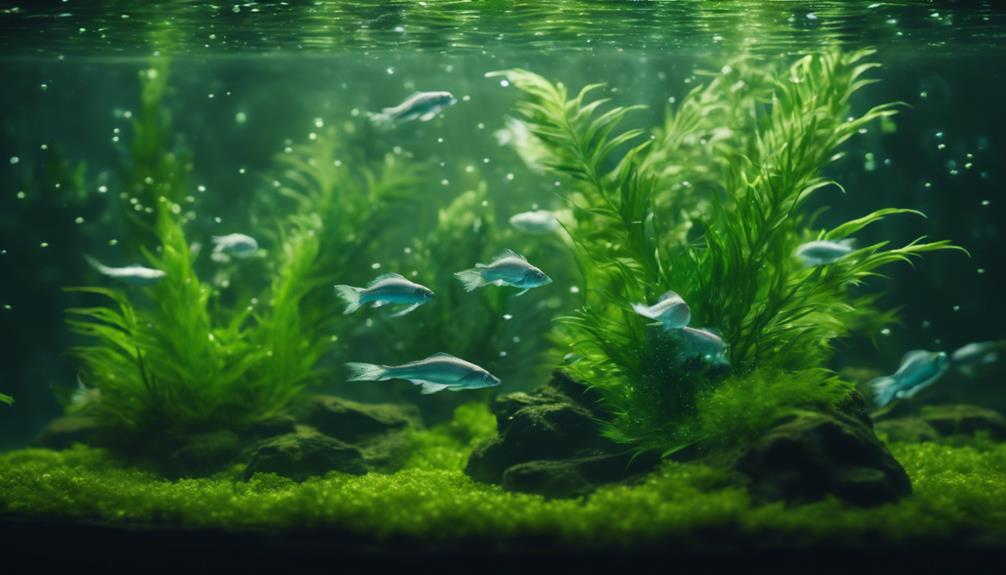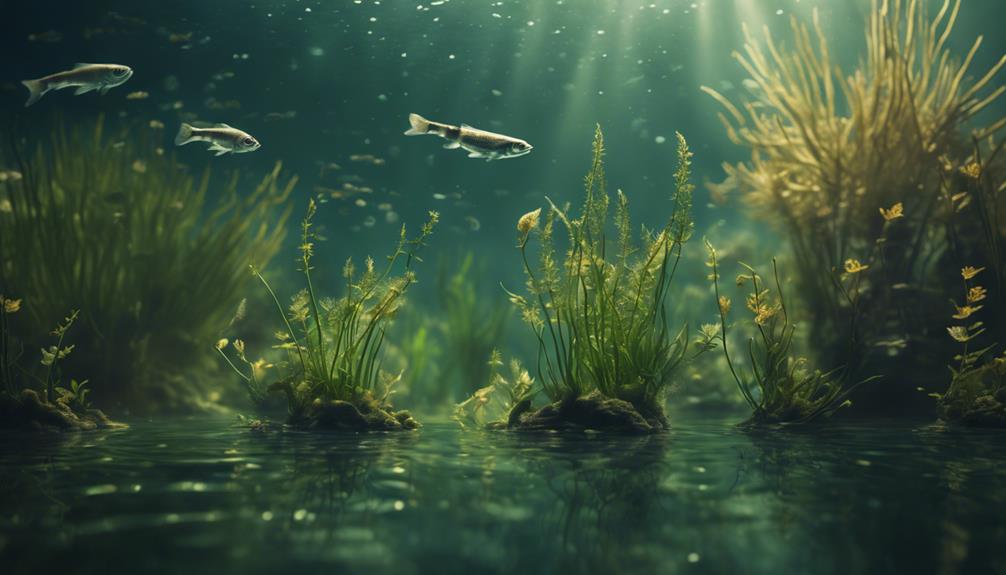You're looking for the most effective aquatic plants to boost oxygen levels and purify water in your setup. Hornwort, Eelgrass, Green Cabomba, Red Ludwigia, and Anacharis are your top choices. Hornwort releases up to 5.4 mg of oxygen per gram of plant material per hour, while Eelgrass absorbs nutrients, making it an effective natural filter. Green Cabomba rapidly consumes waste products, increasing oxygen levels. Red Ludwigia absorbs excess nutrients, promoting oxygenation and nutrient absorption. Anacharis produces up to 3.5 liters of oxygen per kilogram of plant material per day. Take a closer look at these aquatic powerhouses to discover their specific needs and benefits.
Table of Contents
Key Takeaways
- Hornwort releases up to 5.4 mg of oxygen per gram of plant material per hour, making it an effective natural oxygenator.
- Green Cabomba rapidly consumes waste products and produces oxygen at an impressive rate, making it ideal for oxygenating fish tanks.
- Anacharis produces up to 3.5 liters of oxygen per kilogram of plant material per day, making it a highly effective oxygenating plant.
- Red Ludwigia has a rapid growth rate of up to 2-3 inches per week, promoting oxygenation and nutrient absorption in aquatic environments.
- Eelgrass absorbs nutrients, making it an effective natural filter, and provides a natural habitat for fish and other aquatic organisms.
Hornwort for Oxygenation Systems
When selecting aquatic plants for oxygenation systems, you often turn to Hornwort, a fast-growing, submerged species that thrives in a wide range of water conditions.
As a submerged oxygenating plant, Hornwort provides a significant amount of surface area for oxygen production and nutrient uptake, growing up to 10 inches tall and 6 inches wide.
Its ability to release up to 5.4 mg of oxygen per gram of plant material per hour makes it an effective natural oxygenator for aquariums and ponds, boosting oxygen levels and providing a healthy environment for fish.
Additionally, Hornwort is a heavy feeder, absorbing excess nutrients like ammonia, nitrates, and phosphates from the water, which helps prevent algae blooms and maintain water clarity.
By incorporating Hornwort into your oxygenation system, you'll not only increase oxygen levels but also reduce the risk of water pollution.
With its low-maintenance requirements and tolerance for some neglect, Hornwort is an ideal choice for beginners or those new to aquatic plant care, ensuring you can provide the best environment for your fish to thrive.
Eelgrass for Water Quality Improvement
By incorporating Eelgrass into your oxygenation system, you'll create a thriving environment that not only boosts oxygen levels but also provides a natural filter for absorbing excess nutrients and pollutants from the water.
As an oxygenating pond plant, Eelgrass (Vallisneria americana) is an excellent choice for improving water quality. Its long, thin leaves absorb nutrients, making it an effective natural filter that helps maintain healthy dissolved oxygen levels.
With its ability to grow up to 3 feet tall, Eelgrass provides shelter for fish and other aquatic organisms, creating a balanced ecosystem.
As a cold-hardy plant, it can thrive in water temperatures between 65°F to 85°F, making it suitable for ponds and aquariums in temperate regions.
Plus, it's easy to maintain and spread throughout your aquatic garden, as it can be propagated by dividing rhizomes.
Green Cabomba Oxygen Production

With its exceptional ability to thrive in high-lighting conditions, Green Cabomba emerges as a top choice for oxygenating your fish tank, rapidly consuming waste products and producing oxygen at an impressive rate.
As you introduce this aquatic plant to your tank, you can expect it to grow rapidly, absorbing ammonia, nitrates, and phosphates from the water. This process not only cleans the water but also increases oxygen levels, providing a healthier environment for your fish to thrive.
You'll notice that Green Cabomba can grow up to 10 inches tall and 2-3 inches wide, creating a natural habitat for your fish and other tank inhabitants.
To maintain its shape and promote healthy growth, you'll need to prune it regularly. By doing so, you'll encourage the plant to produce much oxygen, making it an ideal choice for oxygenating your fish tank.
Red Ludwigia Aquatic Plant Benefits
You'll find Red Ludwigia to be a highly versatile aquatic plant that can thrive in a wide range of water conditions, making it an ideal choice for oxygenating your fish tank or pond. As a fast-growing plant, it can absorb excess nutrients, such as nitrates and phosphates, from the water, helping to keep your aquatic environment healthy and clear.
Here's a breakdown of Red Ludwigia's benefits:
| Feature | Description | Benefits |
|---|---|---|
| Growth Rate | Up to 2-3 inches per week | Rapid oxygenation and nutrient absorption |
| pH Tolerance | 6.5-8.5 | Suitable for a variety of aquatic environments |
| Maintenance | Relatively low-maintenance | Easy to care for and maintain |
| Habitat | Natural shelter and food for aquatic animals | Provides a healthy ecosystem for fish and other creatures |
As a hardy plant, Red Ludwigia is perfect for aquariums and ponds where rapid oxygenation is needed. By adding it to your waters surface, you'll not only improve oxygen levels but also create a thriving ecosystem for your aquatic friends. With its ability to absorb excess nutrients, Red Ludwigia is one of the best oxygenating plants for maintaining a healthy and balanced aquatic environment.
Anacharis for Healthy Aquatic Ecosystems

Anacharis, another highly effective oxygenating plant, excels at producing oxygen and removing excess nutrients, making it an ideal addition to your aquatic ecosystem.
As a submerged plant, it's capable of producing up to 3.5 liters of oxygen per kilogram of plant material per day, making it a top choice for oxygenation systems.
Anacharis is also highly efficient at removing excess nutrients, such as nitrates and phosphates, which helps prevent excessive algae growth and maintains a balanced ecosystem.
Since plants need a healthy environment to thrive, Anacharis can tolerate varying water temperatures, hardness, and pH levels, making it a great fit for your aquatic setup.
Regular pruning is necessary to keep your Anacharis healthy and promote new growth, as it can grow up to 3 feet per month in ideal conditions.
With its ability to survive in water temperatures as low as 5°C, Anacharis is perfect for ponds and aquariums in cooler climates.
Frequently Asked Questions
What Aquatic Plant Produces the Most Oxygen?
You're looking for the aquatic plant that produces the most oxygen? Well, you're in luck! Hornwort, an oxygen-rich species and photosynthesis booster, is the aquatic superhero you need, producing a whopping 1.25 liters of oxygen per hour.
Which Plant Is the Best Oxygenator of Water?
You're looking for the best oxygenator of water, and it's vital to ponder the plant's photosynthesis process, oxygen release rates, and impact on aquatic ecosystem balance.
What Plants Increase Oxygen in Water?
You're looking for aquatic allies that boost oxygen levels? As water purifiers, oxygen boosters, and aquatic assistants, plants like Hornwort, Eelgrass, and Anacharis work wonders, increasing oxygen in water and creating a healthy habitat for your freshwater friends.
Do Aquarium Plants Help With Oxygen?
You're likely wondering if aquarium plants are the holy grail of oxygenation – and the answer is, they help, but don't solely rely on them! Aquatic plants' benefits include oxygen production through photosynthesis, but oxygen levels fluctuate and water circulation is vital for a balanced ecosystem.
Conclusion
While you may think oxygenation systems are all about machinery, the truth is, nature has its own solutions.
By incorporating these five aquatic plants into your system, you'll not only boost oxygen levels but also create a thriving ecosystem.
On one hand, Hornwort and Anacharis provide a natural filter, while on the other, Eelgrass and Green Cabomba work to purify the water.
And then there's Red Ludwigia, which adds a pop of color to the mix.
The result? A harmonious balance that's both efficient and beautiful.

